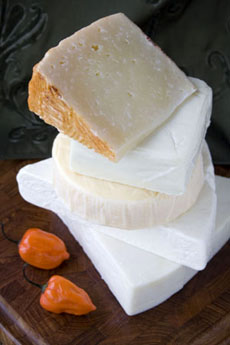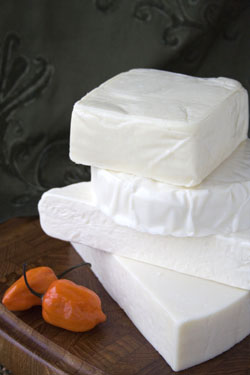

From top: Roth Käse GranQueso, Queso Blanco and Queso Quesadilla from El Viajero, Roth Käse Cotija and El Viajero Cotija. Photography by Claire Freierman | THE NIBBLE.
|
STEPHANIE ZONIS, Contributing Editor, focuses on good foods and the people who produce them.
|
|
March 2008
|
 |
Hispanic Cheese
Page 5: Cooking With Hispanic Cheeses
- Click here to read other months’ Whey To Go columns
This is Page 5 of a five-page article. Click on the black links below to visit other pages.
Using Hispanic Cheeses
While aged Hispanic cheeses tend to have distinct, sharper flavors, there’s more leeway in the use of fresh and melting cheeses. Don’t think you must stick to the same cheese within a category again and again, just because you’re familiar with it or it’s what’s called for in a recipe. For instance, in the fresh cheese category, try substituting Queso Para Freir for Queso Blanco, or Queso Quesadilla for Queso Oaxaca. Substitutions will also depend upon what you can find locally, but as Hispanic cheeses begin to filter into an ever-wider area, that should become easier with time—half of the top 10 fastest-growing specialty cheeses at retail are Hispanic cheeses, as an increasing number of non-Hispanic consumers incorporate them into their cooking.
Once you’re a little more familiar with Hispanic cheeses, you’ll discover at least one suitable for almost every type of dish and any occasion. Make it a point to try some Hispanic cheeses soon. Their versatility and good taste will quickly win you over.
Pairing Wine & Beer With Hispanic Cheeses
While these cheeses are great in Latino recipes, many are also perfect as table cheeses. And when it comes to pairing them with alcohol, international wines and beers can be great matches.
For instance, PRP Wine International and the California Milk Advisory Board suggest a lighter, crisp, mildly fruity wine with fresh Hispanic cheeses, such as a Sauvignon Blanc, Riesling, or Rose. In any case, you want a wine that won’t overwhelm the cheese’s delicate nature.
If you’re quaffing sangria, try it with a Queso Blanco (Queso Fresco and Queso Blanco can both be served with mangoes, guavas, and other tropical fruits, too).
If your cooked dish contains Enchilado Añejo, a Pilsner beer or Chardonnay is a good accompaniment. Cotija is a fine match with a lager or full-bodied red wine. Manchego is a classic with Rioja or Merlot. And the list goes on.
|

A study in white: queso blanco, queso fresco and two cotijas. While the names are Latino, these particular cheeses are made in Wisconsin. |
Finding Hispanic Cheeses
Unless you live in an area with a predominantly Latino population, availability of some Hispanic cheeses may be limited at present. Marilyn Wilkinson of the Wisconsin Milk Marketing Board notes that the harder, aged cheeses will probably be the most difficult to find in your local grocery store, although many upscale markets now carry up to several kinds of fresh and melting Hispanic cheeses. As far as country of origin, Ms. Wilkinson declares that Hispanic cheeses most accessible now will likely be Mexican-style cheeses made in the U.S. Finding Duroblando from Mexico, for instance, might be a real challenge. But, as noted earlier, this will change with time.
As usual, a knowledgeable retailer or cheesemonger can be your best friend when it comes to finding these cheeses. But education is always a slow process, and many general retailers don’t yet know about these cheeses, their types or their uses. Fortunately, because most Hispanic cheeses are sold prepackaged, labels will frequently have recipes or give you a clue about how the cheese can be used (such as “perfect for melting”).
If you’re searching for a particular Hispanic cheese, it can make matters a little easier, as you can go to your retailer with a specific name. The web can be a help in looking up Hispanic cheese types, although not all web information is entirely accurate. And restaurants can be a great source of information, too. If you’re in a restaurant with a Latino cuisine, and you enjoy a dish made with cheese, don’t hesitate to ask about the cheese and local suppliers. If they have minimum orders, that’s the perfect reason to have a Hispanic cheese tasting party. And use the occasions to experiment with pairing those wines and beers, as well!
Go To The First Page Of This Article
Go To The Article Index Above
Sources and Acknowledgements
Lifestyle Direct, Inc. All rights reserved. Images are the copyright of their respective owners.

|





